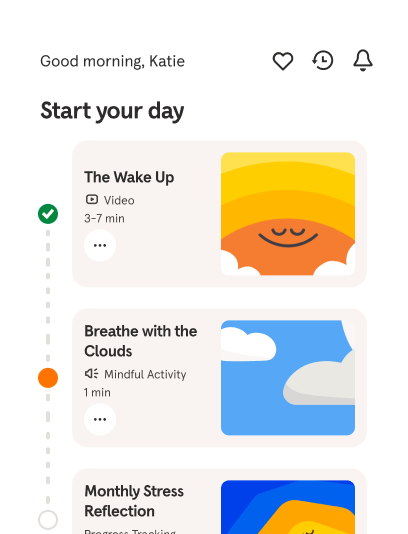Relaxation
Use this breathing exercise to relax and uncover a sense of stillness beneath whatever thoughts, feelings, or external distractions you might be facing.
Try 14 days freeBetter mental health starts with Headspace. Unrivaled expertise to make life feel a little easier, using guided meditations, mindfulness tips, focus tools, sleep support, and dedicated programs.
Try 14 days free
Believe it or not, relaxation is readily available for us. Yet, oftentimes, it can feel like a distant stranger. In this practice, we use the breath as a way to connect to that deeper sense of relaxation and stillness that's usually beneath our many thoughts, feelings, and sensations. Sometimes you can think, I'll relax when I do this, or how can I relax when I have so many things to do? And what we're doing here is relaxing with what is. Letting go of striving, of doing, to just be, because we may come here wanting to relax, or with the goal to be relaxed, and realize as soon as we close our eyes, it seems impossible. So whatever arises in this practice today, we'll use the breath to meet our thoughts, feelings, sensations with a sense of spaciousness, allowing us to connect to a greater sense of relaxation. So taking a moment here just to get comfortable, sitting upright or lying down, whatever feels best for you and your body. And just notice how you're arriving to this practice today. Maybe there's an emotion present, a thought, a sensation. Just noticing it, not judging it, or thinking too much about it. And then inviting you now to take three deep breaths, breathing in through the nose, expanding the belly, and breathing out through the mouth. On the next exhale, if you'd like, slowly closing the eyes, returning the breath back to its natural rhythm, noticing the body soften, and sink further into the cushion or floor beneath you. And just taking a moment here to check in with your senses, like noticing any sounds around you in your space. And then getting clear on your intention for today. Identifying what your purpose is for doing this exercise. And bringing to mind others in your life who will benefit from you being here. Remembering that the intention here isn't to try, or to force the sense of relaxation, but more to relax with what is. Gently guiding the focus now back to the body, and scanning the body from head to toe. Noticing any areas of discomfort, or restlessness in the body. And also noticing where the body feels more relaxed. Again, not thinking about it too much, just noticing what's there, and allowing it to be as it is. Once you reach the soles of the feet, resting the focus on the breath now. And just gently noticing how you're breathing. Noticing the quality of the breath, and what the breath feels like in the body, that rising and falling sensation. And to help connect us to a greater sense of relaxation in the mind and in the body, let's breathe in through the nose to the count of two, and breathe out through the mouth to the count of four. Making sure we're breathing into the belly slowly and deeply. Maybe placing a hand on the stomach if that's helpful. So breathing in for one, two, and breathing...
Details
About your teachers
 Andy PuddicomeHeadspace Co-founderMore about Andy
Andy PuddicomeHeadspace Co-founderMore about AndyA former Buddhist monk, Andy has guided people in meditation and mindfulness for 20 years. In his mission to make these practices accessible to all, he co-created the Headspace app in 2010.
 Eve Lewis PrietoHeadspace Director of MeditationMore about Eve
Eve Lewis PrietoHeadspace Director of MeditationMore about EveEve is a mindfulness teacher, overseeing Headspace’s meditation curriculum. She is passionate about sharing meditation to help others feel less stressed and experience more compassion in their lives.
 Dora KamauMeditation TeacherMore about Dora
Dora KamauMeditation TeacherMore about DoraAs a meditation teacher, Dora encourages others to live, breathe, and be with the fullness of their experiences. She loves meditation’s power to create community and bring clarity to people’s minds.
 Kessonga GiscombeMeditation TeacherMore about Kessonga
Kessonga GiscombeMeditation TeacherMore about KessongaKessonga has been an acupuncturists, therapist, and meditation teacher, working to bring mindfulness to the diverse populations of the world.
 Rosie AcostaMeditation TeacherMore about Rosie
Rosie AcostaMeditation TeacherMore about RosieRosie Acosta has studied yoga and mindfulness for more than 20 years and taught for over a decade. Rosie’s mission is to help others overcome adversity and experience radical love.

Your lifelong guide to better mental health
Stress, sleep, and all the challenging emotions — care for your mind with the everyday mental health app that's shown to make a difference.
Try 14 days free
Look after your mind
Proven guided meditations and programs to help you stress less, sleep more soundly, and better navigate life’s challenges

Science-backed
Studies show that using Headspace for 30 days can reduce stress, increase resilience, and improve overall well-being

Explore 1000+ expert-led exercises
Access our library of meditations, breathing exercises, and guidance videos for stress, sleep, focus, everyday anxiety , parenting, and more.




Members are enjoying happier and healthier lives
Frequently asked questions
- How do you meditate to relax?
Relaxation doesn’t always come easily or naturally for most of us, due to the busyness of life and the busyness of the mind. Even when we’re on vacation, it can take a few days to unwind. Getting better at relaxation takes practice, and that’s why a relaxation meditation is a good place to start because it cultivates stillness and calmness, even if it’s only for 10 minutes a day. That calm is cultivated by sitting somewhere comfortable, closing your eyes, and focusing on the breath — that’s all there is to it. No matter how many or how often thoughts or feelings arise, you simply acknowledge them and return your attention to the breath. Rinse and repeat. With practice, meditation becomes the gateway to relaxation, for mind, body, and soul.
- How does meditation help you relax?
A relaxation meditation induces what is called “the relaxation response”. By using the breath to anchor awareness in the moment, meditation is a tool that’s been shown to help manage and ease stress because it stimulates the parasympathetic nervous system and, as a result, stops the release of stress hormones like cortisol. Your heart rate decreases and your blood pressure lowers, and you start to feel calmer. A 2018 study found that people who used the Headspace app for 10 days saw a 12% decrease in stress; after 30 days, they reported a 32% decrease.
- How is meditation different from relaxation or sleeping?
When you truly relax and sleep, the mind drifts into a place of non-awareness. For a lot of people catching their Zzz’s, they disappear into a dream state. With meditation, there is an intention to stay alert, awake, and focused (on whatever object of focus is being used) as you bring your full presence to the present moment. This way, the mind stays anchored to a place of awareness. A relaxation meditation seeks to find that sweet spot between relaxation and focus — relaxed enough to ease down but focused enough not to fall asleep.
- How to relax during meditation
One of the simplest ways to relax is to take some deep diaphragmatic breaths, also called belly breathing. By shifting your breathing rate, you stimulate the parasympathetic nervous system, and trigger a calming response. The other way is to rely on a relaxation meditation (which has the same calming effect on the nervous system) because you are focused on the breath to keep you anchored to the present moment, letting go of all distractions. Simply sit somewhere comfortable, close your eyes, take a few deep breaths to start with, and then return to your natural rhythm of breathing. Place your attention on each breath — the rise and fall of the chest — and use that rhythm as the object of focus to return to each time a distracting thought arises.
- © 2025 Headspace Inc.
- Terms & conditions
- Privacy policy
- Consumer Health Data
- Your privacy choices
- CA Privacy Notice


